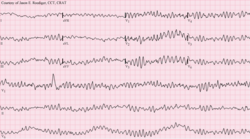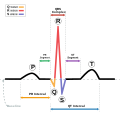Cardiomyopathy
The word cardiomyopathy means "heart muscle disease". Cardiomyopathies are a group of diseases in which the function of the myocardium (heart muscle) is impaired for any reason. People with cardiomyopathy are often at risk of arrhythmia and/or sudden cardiac death.[1]
There are four main types of cardiomyopathy:[2]
- Dilated cardiomyopathy (DCM) is the most common form. Patients with this disease usually undergo heart transplantation. In DCM the heart (especially the left ventricle) is enlarged and the pumping function is impaired.
- Hypertrophic cardiomyopathy (HCM or HOCM) is a genetic disorder in which the heart muscle is thickened, which can block blood flow and prevent the heart from functioning properly.
- Arrhythmogenic right ventricular cardiomyopathy (ARVC) is caused by an electrical disturbance of the heart in which heart muscle is replaced by fibrous scar tissue. The right ventricle is generally most affected.
- Restrictive cardiomyopathy (RCM) is the least common cardiomyopathy. The walls of the ventricles are stiff, but may not be thickened, and resist the normal filling of the heart with blood.
Cardiomyopathy Media
The arrhythmia, ventricular fibrillation, seen on an ECG
References
- ↑ Kasper, Denis L.; et al. (2005). Harrison's Principles of Internal Medicine, 16th edn. McGraw-Hill. ISBN 0-07-139140-1.
- ↑ Cardiomyopathy Association. "About cardiomyopathy". Archived from the original on 2006-09-25. Retrieved 2007-05-31.



